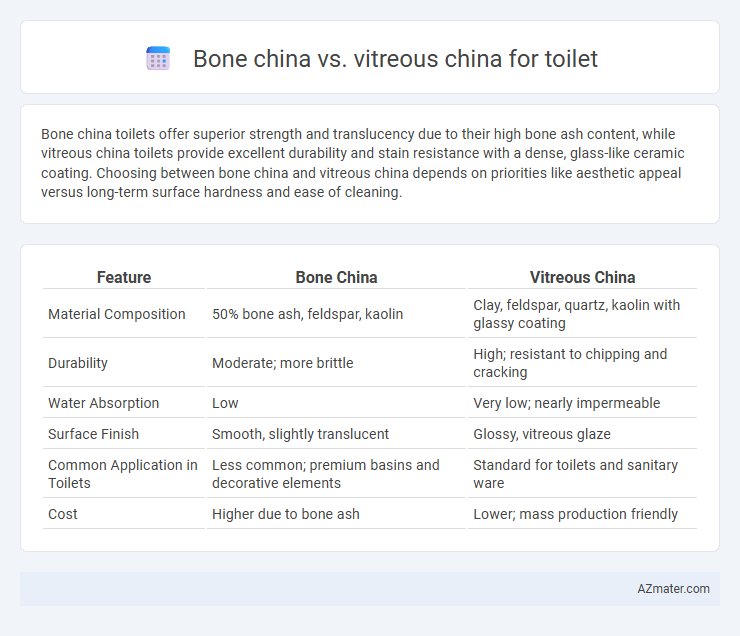Bone china toilets offer superior strength and translucency due to their high bone ash content, while vitreous china toilets provide excellent durability and stain resistance with a dense, glass-like ceramic coating. Choosing between bone china and vitreous china depends on priorities like aesthetic appeal versus long-term surface hardness and ease of cleaning.
Table of Comparison
| Feature | Bone China | Vitreous China |
|---|---|---|
| Material Composition | 50% bone ash, feldspar, kaolin | Clay, feldspar, quartz, kaolin with glassy coating |
| Durability | Moderate; more brittle | High; resistant to chipping and cracking |
| Water Absorption | Low | Very low; nearly impermeable |
| Surface Finish | Smooth, slightly translucent | Glossy, vitreous glaze |
| Common Application in Toilets | Less common; premium basins and decorative elements | Standard for toilets and sanitary ware |
| Cost | Higher due to bone ash | Lower; mass production friendly |
Introduction: Understanding Bone China and Vitreous China
Bone china and vitreous china are two distinct materials commonly used in toilet manufacturing, each offering unique properties and benefits. Bone china is a type of porcelain known for its high concentration of bone ash, resulting in superior strength, translucency, and a smooth, white finish. Vitreous china, on the other hand, is a ceramic material coated with a glass-like enamel that enhances durability, stain resistance, and ease of cleaning, making it a popular choice for toilet surfaces.
Composition and Material Differences
Bone china toilets incorporate bone ash derived from animal bones within their ceramic composition, enhancing translucency and durability while maintaining a lightweight structure. Vitreous china toilets consist primarily of clay, feldspar, and quartz reinforced with a glassy coating that provides a dense, non-porous surface, ensuring superior stain resistance and ease of cleaning. The key material difference lies in the use of bone ash in bone china, offering higher strength and a delicate finish compared to the robust, glossy finish of vitreous china made from refined clay mixtures and vitrification processes.
Manufacturing Processes Compared
Bone china toilets are crafted using a blend of bone ash, feldspathic material, and kaolin, resulting in a dense, durable ceramic with a distinctive white translucency due to high firing temperatures around 1200degC. Vitreous china toilets employ a firing process between 1200degC and 1400degC on a mixture primarily of feldspar, kaolin, and quartz, producing a highly vitrified, non-porous surface known for exceptional strength and stain resistance. The manufacturing process of bone china emphasizes translucency and fine texture through precise bone ash incorporation, while vitreous china focuses on achieving a glass-like glaze for enhanced durability and ease of cleaning.
Appearance and Aesthetic Qualities
Bone china toilets feature a translucent, luminous surface with a warm ivory tone that adds an elegant, high-end appeal to bathroom designs. Vitreous china toilets have a smooth, durable, and highly glossy glaze, offering a bright white appearance that complements modern and traditional styles alike. The subtle warmth of bone china contrasts with the crisp whiteness of vitreous china, influencing the overall ambiance and visual harmony of the bathroom space.
Durability and Strength
Bone china toilets offer exceptional durability due to their high density and calcium phosphate content, making them resistant to chipping and cracking. Vitreous china toilets feature a glass-like coating that enhances surface strength and prevents stains and scratches, ensuring long-lasting performance. Both materials provide strong, durable options, but vitreous china is more commonly used in toilets for its optimal balance of hardness and ease of maintenance.
Water Absorption and Stain Resistance
Bone china toilets exhibit lower water absorption rates compared to vitreous china, enhancing their durability and making them less prone to water-related damage. The high mineral content in bone china contributes to superior stain resistance, preventing discoloration from common bathroom residues. Vitreous china, while also resistant, tends to absorb slightly more water, increasing the risk of staining and requiring more frequent cleaning to maintain its appearance.
Weight and Handling
Bone china toilets remain lighter due to their composition, which includes bone ash, offering easier handling during installation and maintenance. Vitreous china, known for its durability and dense, glass-like surface, tends to be heavier, making it more challenging to maneuver. The lighter weight of bone china models can reduce strain on installers and improve ease of placement in tight bathroom spaces.
Cost Comparison
Bone china toilets generally come at a higher price point due to their composition of bone ash, offering increased strength and a smoother finish compared to vitreous china. Vitreous china toilets are more cost-effective, made from ceramic coated with a durable glaze that provides good resistance to stains and scratches. For homeowners prioritizing budget, vitreous china presents an affordable option, while bone china appeals to those seeking premium quality despite the added expense.
Environmental Impact and Sustainability
Bone china toilets, made from translucent porcelain incorporating bone ash, generally require higher energy consumption during manufacturing due to their refined firing process, resulting in a larger carbon footprint compared to vitreous china. Vitreous china toilets are known for their durability and resistance to staining, produced through a glazing process that enhances sustainability by reducing frequent replacements and water usage. Opting for vitreous china fixtures often supports eco-friendly construction practices by minimizing energy usage and promoting long-term waste reduction.
Which is Best for Toilets: Final Verdict
Vitreous china is the best choice for toilets due to its superior durability, non-porous surface, and resistance to stains and odors, making it highly hygienic for bathroom use. Bone china is typically reserved for fine tableware because of its translucent quality and delicate nature, which are less practical for heavy-use bathroom fixtures. Therefore, vitreous china combines strength and ease of maintenance, offering optimal performance for toilets.

Infographic: Bone china vs Vitreous china for Toilet
 azmater.com
azmater.com